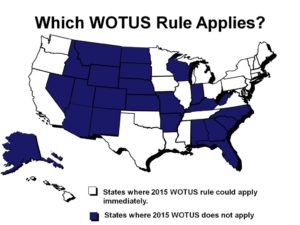Immediately upon his inauguration on Jan. 20, President Biden signed 17 Executive Orders (EOs), some of which reversed decisions made by the Trump administration while others delayed the implementation of pending regulatory changes. While these EOs target a response to COVID-19, financial relief for Americans, human rights, immigration and ethics, three EOs targeted issues with regard to our environment, including the pending Nationwide Permits as well as the previously adopted Waters of the United States (WOTUS) rule. Below is a summary of these orders:
Protecting Public Health and the Environment and Restoring Science to Tackle the Climate Crisis
This Executive Order establishes the Biden administration’s commitment to immediately work to confront both the causes and impacts of climate change by implementing policy guided by science. The order rolls back many actions taken by the previous administration to loosen environmental standards and protections that may be inconsistent with Biden’s articulated policy.
Specific actions targeted for review include Waters of the United States (now called Navigable Waters Protection Rule) which went into effect on June 22, 2020 and the 2021 Final Nationwide Permits (NWP) which expire on March 18, 2022.
Modernizing Regulatory Review
This Executive Order directs the Director of the OMB to begin evaluating the processes and principles that govern regulatory review to ensure swift and effective federal action. The goal is to produce a set of recommendations for improving and modernizing regulatory review. This EO states that recommendations should consider ways that the Office of Information and Regulatory Affairs (OIRA) can play proactive role in partnering with agencies to undertake regulatory initiatives.
Revocation of Certain Executive Orders Concerning Federal Regulation
This Executive Order directs the Office of Management and Budget (OMB) and agency heads to rescind any orders, rules, regulations, etc. that impede the federal government’s ability to confront urgent challenges facing our nation including the COVID-19 pandemic, economic recovery, racial justice or climate change.
President Biden also issued a memorandum declaring a Regulatory Freeze Pending Review. This directive places a freeze on all new regulations put in motion by the previous administration to give his administration time to evaluate which ones it wants to move forward on. This minimum 60-day postponement on implementation of any rules that have not yet taken effect include the final 2021 NWPs which are set to expire on March 18, 2022. In addition, the Ohio EPA released a public notice of the draft of Section 401 Water Quality Certifications for the proposed 2020 NWPs on Dec. 16, 2020 with a comment period set to expire on Feb. 11, 2021. The pause outlined in this memorandum could affect any further movement on the NWPs.
The Stream + Wetlands team is currently reviewing these Executive Orders, will continue to monitor activities surrounding their impact and are available to discuss how they could affect your projects.



